Symbols
THE FAMILY OF BIG BRIDGES OF OUR CAPITAL CITY IS GROWING
A New Bond of the Sava Banks
The seventh big bridge on the Belgrade rivers had a spectacular opening in the first minute of New Year 2012. Since it is hanging on a giant pylon, Belgrade people have given it the name Obeshenyak (Serbian: ‘cutup’ or ‘the hanging one’), used for unforgettable people of the famous Belgrade charm. At the time the eighth bridge of the capital city is being erected on the Danube near Zemun, let us remind you how some of the previous bridges were built, named and destroyed
Text: NR Press
Photo: Dragan Bosnić
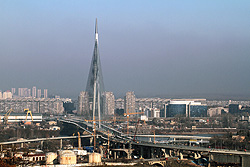 Unlike people, who are mostly born and die with one name, big edifices, bridges for example, have several. One name is given by the ones it serves, second by its architects, third by its purpose, and the fourth is the official one (most often after highly regarded people). Unlike people, who are mostly born and die with one name, big edifices, bridges for example, have several. One name is given by the ones it serves, second by its architects, third by its purpose, and the fourth is the official one (most often after highly regarded people).
When numerous Belgradians rushed to cross the new bridge over the Sava near Ada Ciganlija for the first time in August 2011, besides unhidden admiration of the architectural undertaking, the issue of the name was immediately raised. Belgrade people, known as endlessly witty, soon offered several very lucid suggestions. One of them is especially remarkable. But we’ll tell this story later.
KING’S, SCHWAB’S, BROTHERHOOD, BRANKO’S
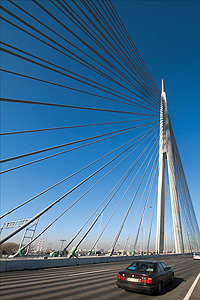 Among all the big Belgrade bridges (seven at the moment), the most interesting is certainly the history of the chain bridge over the Sava, connecting the banks of the Sava in Belgrade and Zemun, later Old and New Belgrade. Its first name was Bridge of Alexander I Karadjordjević, and it was destroyed in World War II. Later, in the same place, the Bridge of Brotherhood and Unity was erected, later called Branko’s bridge (after the poet Branko Radičević, whose street it joins, although many people of Belgrade think it was named after Branko Ćopić, also famous writer, who tragically ended his life by jumping from that bridge.) Among all the big Belgrade bridges (seven at the moment), the most interesting is certainly the history of the chain bridge over the Sava, connecting the banks of the Sava in Belgrade and Zemun, later Old and New Belgrade. Its first name was Bridge of Alexander I Karadjordjević, and it was destroyed in World War II. Later, in the same place, the Bridge of Brotherhood and Unity was erected, later called Branko’s bridge (after the poet Branko Radičević, whose street it joins, although many people of Belgrade think it was named after Branko Ćopić, also famous writer, who tragically ended his life by jumping from that bridge.)
Let us start from the beginning.
In the year 1930, a public invitation was issued for the construction of a road bridge over the Sava. As for the construction of the first (railway) bridge, the job was given to a foreign company from Oberhausen, Germany. It began in July 1930, and the bridge was opened for traffic on December 16, 1934. Many problems appeared during the construction (property relations, lack of money, the spare parts and salaries were late…), however all this was, naturally, soon forgotten.
The hanging construction was designed looking up to the bridge over the Rheine in Cologne, the only one of its kind in Europe at the time. The Belgrade one, however, claimed old Belgrade citizens, was even more beautiful. Slimmer and more elegant. It had two main reinforced concrete pillars (pylons). Steel wire ropes between them carried the whole construction. The span of the bridge over the river was 261 meters.
 The ceremonial opening of the Bridge of Alexander I Karadjordjević on December 16, 1934 was held in deep mourning. The king the bridge was named after was assassinated on October 9 in Marseille. On December 17, 1934, the Politika daily reported: The ceremonial opening of the Bridge of Alexander I Karadjordjević on December 16, 1934 was held in deep mourning. The king the bridge was named after was assassinated on October 9 in Marseille. On December 17, 1934, the Politika daily reported:
”The Bridge of King Alexander was yesterday ceremonially opened for traffic. Although the ceremony did not have the greatest proportions due to national mourning, the bridge carrying the name of the blessedly resting King was consecrated in the presence of the most reputable people and many citizens. His Royal Highness Prince Pavle opened the Bridge of King Alexander for traffic.”
 – This bridge is a first degree cultural work… During the rest of the century it will be the witness of our technological ability and as such is a masterpiece, the cutting-edge work of modern technology – said Stjepan Skrulj, PhD, minister of construction, at the opening. – This bridge is a first degree cultural work… During the rest of the century it will be the witness of our technological ability and as such is a masterpiece, the cutting-edge work of modern technology – said Stjepan Skrulj, PhD, minister of construction, at the opening.
Testing of such a bridge was not easy at the time. First it was crossed by horsemen, 700 of them. Then municipal tanks and trucks tested it. Cars, rare at the time, crossed the bridge, and somewhat later the tram line connecting Belgrade and Zemun.
This beautiful bridge unfortunately did not last long. When the German attack on Belgrade and Yugoslavia began, in the night between April 10 and 11, 1941, the Yugoslav army, with the intention to prevent or at least make the entrance of the Germans into the capital city more difficult, decided to destroy all three existing bridges.
Already during World War II, in the vicinity of the destroyed bridge, the Germans built their own and named it Bridge of Prince Eugene. In the autumn of 1944, rushing to retreat, they planned to destroy it and make things difficult for the advancing liberating forces. However, people remember that the mined bridge was saved from destruction by Miladin Zarić, a teacher from Belgrade.
After the war, the Belgradians called it Schwab’s Bridge, but the name was soon forgotten. The tram line connecting Old and New Belgrade goes crosses it today and it is simply called the Old Bridge.
FROM THE PANČEVO TO THE CHINESE BRIDGE
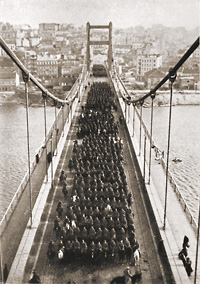 The first real bridge over the Danube, the Pančevo Bridge, the only until 2014, was opened for traffic on October 27, 1935. It was first named after the then juvenile king Petar II Karadjordjević. However the name disappeared after the war, another wasn’t found or didn’t live long, so even today people call it the Pančevo Bridge. The first real bridge over the Danube, the Pančevo Bridge, the only until 2014, was opened for traffic on October 27, 1935. It was first named after the then juvenile king Petar II Karadjordjević. However the name disappeared after the war, another wasn’t found or didn’t live long, so even today people call it the Pančevo Bridge.
This bridge shared the same fate as the other Belgrade bridges. It was first mined by Yugoslav soldiers in April 1941, the Germans later repaired it for their needs during the occupation, but it was damaged during the ”allied bombing” on April 16 and September 3, 1944. It was finished off by the Germans in October 1944 during their retreat from Belgrade. It was restored in the first year after the war, and the first train crossed it on November 7, 1946. The road was opened for traffic on November 29 the same year, on the Day of the Republic.
(...)
We have to skip, understandably, many things. Perhaps it would be most convenient to end the story about Belgrade bridges with the letter of Nikola Arandjelović from Belgrade published in the Politika column ”Between Us”:
. .. I believe most Belgrade people, even guests of our city, will agree that Belgrade is special for many things, but that its main feature is the special spirit and charm, relaxed and spontaneous behavior, acceptance of new settlers and guests or our city without reserve. Foreigners especially admire these things and state they are one of the main reasons of their visit to Belgrade. .. I believe most Belgrade people, even guests of our city, will agree that Belgrade is special for many things, but that its main feature is the special spirit and charm, relaxed and spontaneous behavior, acceptance of new settlers and guests or our city without reserve. Foreigners especially admire these things and state they are one of the main reasons of their visit to Belgrade.
The source of that specific charm… is in the heroes of Belgrade quarters (”neighborhoods” as they would name them), kafanas, streets… all those places where Belgradians and their guests gather. The adventures and thoughts of these city heroes are told for years, they grow and create myths about our city. Writers and poets became famous by describing these heroes and their accomplishments, contributing to their glory and t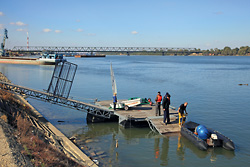 he glory of Belgrade. They were given different names… But it seems we have all forgotten an old world which best describes all those Belgrade heroes: obeshenyaks (Serbian: cuputs, the ones hanging). When have you last heard or used that word? he glory of Belgrade. They were given different names… But it seems we have all forgotten an old world which best describes all those Belgrade heroes: obeshenyaks (Serbian: cuputs, the ones hanging). When have you last heard or used that word?
Isn’t it the real measure and best description for all those known and unknown Belgrade rascals and rascals-to-be, bohemians and dreamers, twiddlers and academicians, beggars and rich ones who, with their every-day jokes, events, skills, courtships, endless discussions in kafanas, verses, drawings and paintings, singing and who knows what else, consciously or unconsciously create the unsurpassable Belgrade charm and joy…? Isn’t the Belgrade ”obeshenyak” one of the Belgrade brands...? Doesn’t it deserve recognition for everything it did to make our city famous all around the world?
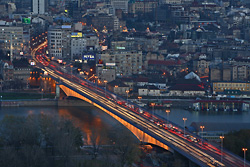 On the other hand, the specific construction of the new bridge over the Sava, high concrete pylon with the powerful steel wire ropes holding the bridge, or onto which the bridge hangs, justifies the suggestion to name the bridge Obeshenyak. ”The Belgrade Obeshenyak”. That name would involve double symbolism of the Belgrade spirit. On the other hand, the specific construction of the new bridge over the Sava, high concrete pylon with the powerful steel wire ropes holding the bridge, or onto which the bridge hangs, justifies the suggestion to name the bridge Obeshenyak. ”The Belgrade Obeshenyak”. That name would involve double symbolism of the Belgrade spirit.
The construction of the bridge over the Danube between Zemun and Borča by a Chinese company is already in progress. Its completion is announced by 2014. Guess how it will be called!
***
Lighter than Temples
”Of all the things a human erects and builds in its urge to live, nothing is better or more valuable for me than bridges. They are more important than houses, lighter, more general than temples. Belonging to everyone and equal to everyone, useful, always erected with a purpose, in a place where most human needs cross, they are more enduring than other edifices and never serve anything secret or evil.” (Ivo Andrić)
***
The Gazelle
The Gazelle Bridge was constructed in 1970.
How did it get such an unusual name?
Belgradians watched it and named it after what they had seen.
”Resembles a gazelle graciously jumping over the river, from one bank to the other.”
***
The Twin
The second bridge in Beška, crossing the Danube, was opened for traffic in 2011. The three new lanes of the Belgrade-Horgos-Budapest highway will run over it (”Corridor 10”). The bridge near the Arkan canal, the longest European bridge over the Danube (2,2 kilometers), is the same as the old one standing next to it, so people have already named it ”The Twin”.
|
